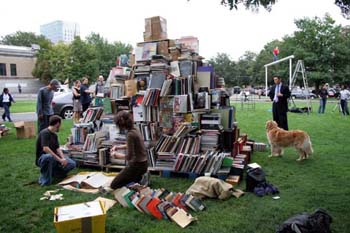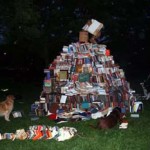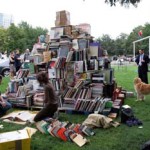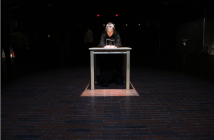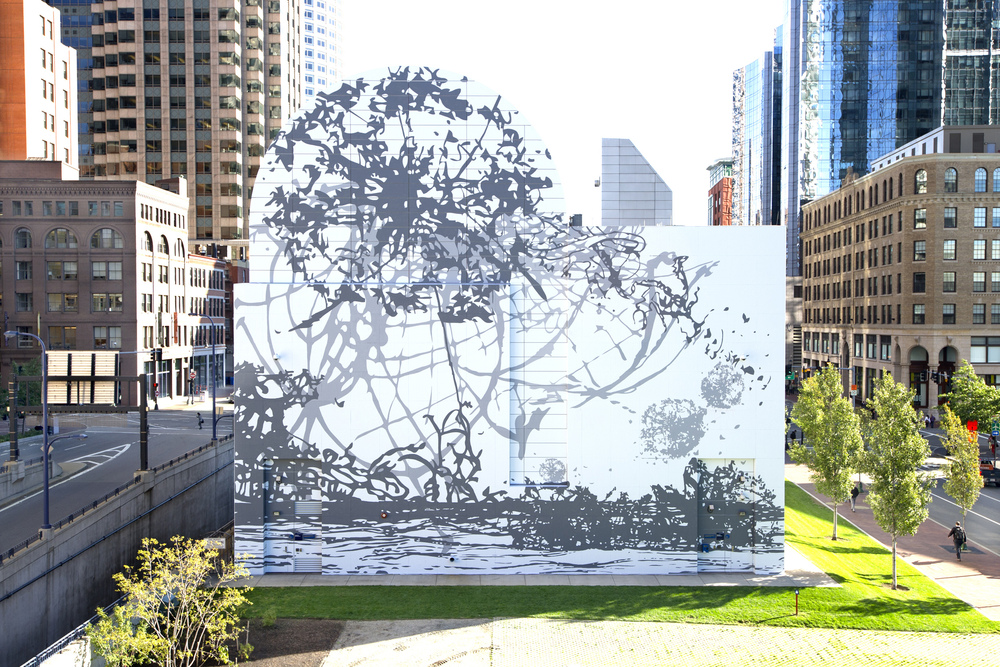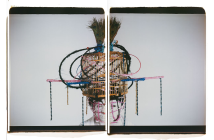In late September, the artist Zhang Huan did a performance entitled “My Boston” on the west lawn of the Museum of Fine Arts. Well known for his performance work in his native China such as “12 Square Meters” (where he sat naked in a public toilet covered with honey and flies) and “To Raise The Water Level of a Fishpond” (where he hired day laborers to stand with him in the middle of a fishpond), Zhang has been based in the U.S. since the late 1990s.
For this particular piece, “My Boston,” Zhang had a pyramid of books built, constructed from donated art history books, art auction catalogues, and contemporary art magazines. The performance began with the loud, droning sound of chanting Buddhist monks, followed by nine dog owners walking their dogs in a clockwise direction around the pyramid nine times. Upon completion, the dog owners leashed their dogs to the base of the pyramid as the artist began crawling toward them from a short distance away, with trails of books fastened to his legs.
At a certain point in his journey, he crawled upon a flagpole with the American flag hoisted above, and when unable to climb to the top, fell back to the ground and lay there. Assistants came forward and covered him in books. Freeing himself from the books, Zhang crawled to the pyramid and became covered again in books. Finally, he ascended the pyramid and sat upon it, with a large book around his neck as a yoke. Smoke streamed from inside the book pyramid while the chanting monks continued their drone. The performance concluded when the audience threw books at the artist atop the smoky pyramid and the dog owners walked the dogs around the pyramid nine times in a counter-clockwise direction.
I find my descriptions to be enfeebled not only by the use of words, but their lack of presence. Often, an unfortunate concern of other performance artists is the need to entertain, to be on stage; as if the wilder and wackier the entertainment is, the better the art is. The startling, and most powerful aspects of the “My Boston” performance were not the actions so much as the atmosphere created during the event, with the audience in full participation. The weather was insistently overcast, and fear arose that the performance would be ruined by rain. Instead, the descending twilight darkness with the overcast sky added to the presence of the performance, the immediacy unfolding in an irreplaceable experience. As the chanting sounds droned on, the atmosphere felt unique, impossible to duplicate, or to prepare for.
Likewise, some of the dogs involved were uncooperative, but appropriate, exhibiting perhaps what Joseph Beuys calls the “invisible power” of animals. Certainly a reason why Zhang Huan has used animals extensively in his performances, starting with flies, then doves, now dogs.
The crux of his performances, however, is himself. In this performance fraught with Buddhist elements (chanting, circling nine times, prostration), one can see the greater tool in the performance of suffering. As with many major performance artists (I think of Abramovic starving herself and Burden being shot with a gun), the personal suffering of a single body becomes an explanation for the whole group, an initiative towards education, and a catalyst for insight. The One whose pain is an example for all the others...sort of like this story I heard about a bearded guy long ago (not an art student) who got nailed to a cross. Or something like that.
Links:
Museum of Fine Arts
"Zhang Huan: Seeds of Hamburg" is on view September 17, 2005 - January 16, 2006 at The Museum of Fine Arts.
All images are courtesy of the artist and the Museum of Fine Arts.

